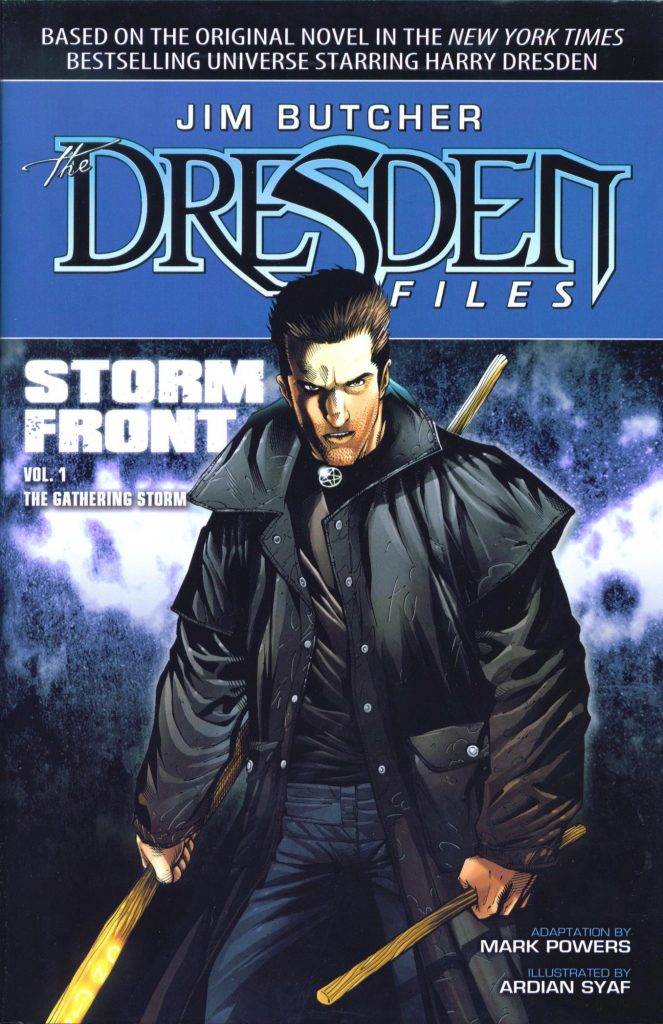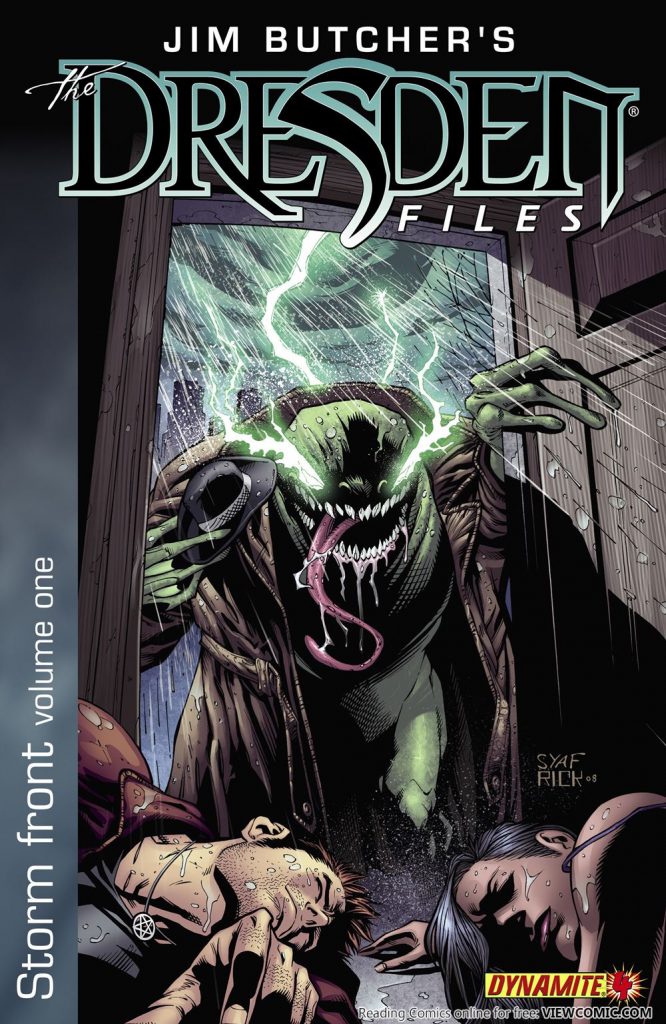The Dresden Files is an iconic urban fantasy mystery series that I have been a fan of for years. In the two decades since its inception, The Dresden Files has received a wide variety of adaptations, including a brief television series, a roleplaying game, and a tabletop card game. Out of all of these, the series of comic book adaptations caught my eye. I recently discovered several volumes at my local library, and I knew that I had to review them. Jim Butcher himself has noted in the introduction to Storm Front Vol. 1 that he always imagined Dresden as a “comic book hero,” and I was eager to see how well cartoons could capture Harry Dresden’s magic.

The first two volumes, “The Gathering Storm” and “Maelstrom,” are based on Storm Front, the first book in The Dresden Files. Mark Powers adapted the story to fit a comic book format, and Adrian Syaf and Brett Booth illustrated it. The story follows Dresden as he works with Chicago Police to solve a double murder committed with black magic. The unfolding mystery is a pleasure to read, regardless of the format.
I was quite impressed by how faithful the comics were to Butcher’s original story. While certain scenes had to be cut in order to fit a 350-page book into two comics, the majority of the plot of Storm Front is echoed beat-for-beat. Powers adeptly figured out which parts of the novel needed to be kept, and which powerful lines from Butcher’s original narration should be included.
The comic itself is well-structured and well-executed. The choice to use black gutters makes the panels pop out and further accentuates the noir atmosphere of the story. I also felt that the variety of panels kept the scenes dynamic. The full single and double-page spreads were used well, but sparingly, accentuating a lively duel or lingering on the gory details of a dead body.

The design choices for this adaptation were also superb. The comic-book style flawlessly brings Butcher’s character descriptions to life, especially when it comes to the eponymous Harry Dresden. Dresden’s lankiness, disheveled nature and brooding face are superbly rendered in these volumes. Syaf tends to depict Dresden a bit more square-jawed and realistic than Booth’s cartoony version, but both styles offer a solid vision of the main character.
While they are visually amazing, some of the characters felt flatter in the comic version than they did in the novel. For example, Susan Rodriguez, a reporter for the Chicago Arcane who wants to interview Dresden, loses a lot of her personality. In Storm Front, when Dresden meets her, he talks about their previous meetings and about their soul-gaze—an intimate moment in which a wizard and the person they are looking at see each others’ past and what drives them. In “The Gathering Storm,” Susan simply shows up and tries to flirt with Dresden in order to obtain information about the case. Little details like their previous meetings or Susan’s personal interests round the character out in the novel, emphasizing that she is more than just another generic seductive woman, and it is truly a shame to skip over them.

Lieutenant Murphy, the officer who hired Dresden to consult for the Chicago Police, receives a similarly shallow treatment. While her relationship with Dresden still retains a certain level of dynamism in the comics, their friendship does not feel as strong as it did in Storm Front. While there is a bonus prequel at the end of “The Gathering Storm” depicting Dresden’s first meeting with Lieutenant Murphy, it does not make up for the lacunae in the comic, especially later in the story, when their relationship becomes strained. A casual reader of the comic might not understand why Dresden is so worried about losing Murphy, whom Storm Front depicts as one of his closest friends.
Some of the world-building which initially drew me to The Dresden Files is also either completely absent or not explained until very late in the comics. Storm Front gives the reader a strong sense of the other magical dimensions that exist alongside the mortal human world, and of the vast variety of mythical creatures and forms of magic. Dresden’s perspective gives the story a very narrow focus, but his offhand remarks allow the reader to imagine an expansive universe and a small but vibrant community of human magic-users, which enchanted me.
I found the magical system much easier to understand when it was explained by Butcher. In the comics, Dresden simply uses words and spells happen. The idea that wizards can tap into their emotions to do magic is not even mentioned until the end of “Maelstrom,” at which point it does not really matter, as it is so late into the series. While the wizard duels are beautifully drawn, I sorely missed the rational meaning of magic, about which Dresden waxes poetic in the original books.
However, one aspect that I appreciate regarding the lack of narration in the comics is the absence of misogyny. Dresden, who calls himself “old fashioned,” is somewhat sexist. This attitude is openly acknowledged by both him and other characters. While it is fine to create a flawed character, Dresden’s attitude can still become tiresome, especially since he’s narrating the story. The way he objectifies every woman he meets is almost endemic to mystery stories, but his constant condescension doesn’t have to be. Since the comics only contain small snippets of the original book’s narration, Dresden’s comments about women are often not carried over. Dresden’s sense of compassion and drive to help others remain clear, but are free of their undertone of sexism.
I also appreciated a lot of the bonus material in the comics. The prequel chapter, cover gallery, and pencil sketches provide a glimpse into the artists’ quest to embody Dresden. The illustrators involved in this project are top notch, and I always love a peek behind the curtain into the work of adaptation.
Overall, ”The Gathering Storm” and “Maelstrom” provide one of the closest adaptations of a novel that I’ve ever read, and the series masterfully captures the principal characters and plot, even if it lacks some of the nuance in the relationships and fantasy lore. The dynamism of the comics adds even more punch and darkness to the mystery. Butcher himself has signed off on the comics as true to his vision of Dresden; there is no higher praise than that. I recommend these comics to fans of The Dresden Files, but if this is your first encounter with the series, then the original novels are unbeatable.


